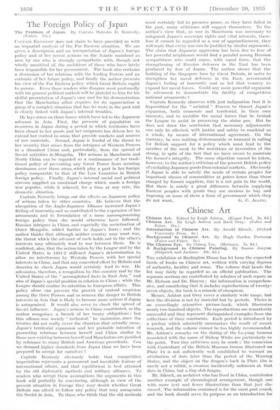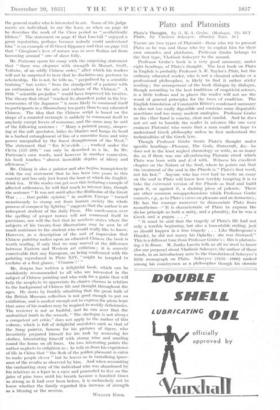Chinese Art
Background to Chinese Art. By Hugh Gordon Porteous. (Faber and Faber. 2s.)
The Chinese Eye. By Chiang Yea. (Methuen. 7s. 6d.) A Background to Chinese Painting. By Soame Jenyns: (Sidgwick and Jackson. 10s. 6d.) A Background to Chinese Painting. By Soame Jenyns: (Sidgwick and Jackson. 10s. 6d.)
TnE exhibition at Burlington House has let loose the expected horde of books on Chinese art, written with varying degrees of authority, lucidity and sense. The volume that heads the list may fairly be regarded as an official publication. The
separate sections are contributed by scholars of such repute 'as Mr. Hobson and Dr. Binyon ; the information is comprehena sive, and considering that it includes reproductions of twenty
seven objects, the book is a.'miracle of cheapness.
Messrs. Ashton and Gray .cover a similarly wide range, but
here the division is not by material but by periods. Theirs. is an exceedingly attractive picture-book, which' illustrates nearly two hundred objects. The reproductions are remarkablY
successful and they represent distinguished examples from the collections of three continents. Each period is introduced. by a preface which admirably summarises the result of recent research, and the volume cannot be too, highly recommended:
Mr. Ashton's remarks on the dating•of the Lo-yang bronzes associated with the name of Bishop White are particularly. to
the point. Two tiny criticisms may be made ;.- the connexion with Canterbury of the British Museum bronze illustrated on Plate 14 is not sufficiently well established to warrant` `an attribution' of date later than the period of the Warring States, and the object on the dragon's back in Plate • 13n• is surely not a rabbit, a creature' incidentally unknown .at that date in China; but a ling chih fungus. . • Mr. Silcock, an architect who has lived in China, contributes another example- of chronological arrangement, though one with more text and fewer illustrations than that just dis- cussed.' The information contained is for the most part soundi and the book should serve its purpose as an introduction for the general reader who is interested in art. Some of his judge melds are individual, to say the least, as when on page 43 he describes the work of the Chou period as " aesthetically lifeless." The statement on page 47 that Lao-toil " enjoyed a great reputation, perhaps because nobody could understand him" is an example of ill-timed flippancy and that on page 112 that " Giorgione's love of nature was to save Italian art from becoming sensual " one of sheer folly.
Mr. Porteous opens his essay with the surprising statement that " there was elegance with strength in. Mozart, Swift, Voltaire, of an oddly Chinese order," after whieh his readers will not be surprised to hear that he disclaims any pretence to scholarship. He is not, he tells us, " prejudiced by a scientific training " but writes " froM the standpoint of a painter with an enthusiasm for the arts and culture of the Chinese." A little " scientific prejudice " would have improved his treatise. The theory that ritual " reached its absurdest point in the tea- ceremonies of the Japanese " is more likely to commend itself to participants in a Bloomsbury tea-party than to any educated. Chinese. The idea that the Chinese script is based on the shape of a rounded rectangle is unlikely to commend itself to anybody except lovers of nonsense, and• the same may be said of the following sentence : " Many a painted peony, simper- • ing at the soft spectator, hides its blushes and hangs its head in a barbed entanglement of line of a muscular force and wiry. power unequalled by the finest draughtsman of the West." The statement that " Ku Wai-chih . . worked under the Chen (557-580) " can only be described as a lie. In Mr. Porteous's own words, used however in another connexion, his book touches " almost incredible depths of idiocy and effeteness."
Mr. Chiang is also a painter and also begins inauspiciously with the coy statement that he has been two years in this country and has only just learnt the hour at which the English drink tea. if the reader can get over this irritating example of affected artlessness, he will find much to interest him, though the sentence " It was not until after the disillusion of the Great War . . . that public opinion " in modern Europe " turned unanimously to stamp out from human society the whole process of conquest by fighting " suggests that the author is an infrequent student of the daily Press. His carelessness over the spelling of proper names will not commend itself to precisions, nor will the fact that he nowhere states where the subjects of his twenty-four illustrations may be seen be of much assistance to the student who would really like to know. However, as a description of the sort of impression that Chinese painting makes upon an educated Chinese the book is worth reading, if only that we may marvel at the difference between Eastern and Western art criticism ; it is scarcely conceivable that any European, on being confronted with the painting reproduced in Plate XIV, ".might be tempted to exclaim at a first glance, Cezanne
Mr. Jenyns. has written a delightful book, which. can be confidently recommended to all who are interested in the subject of Chinese painting and who wish for a guide that will help• the neophyte to appreciate its elusive charms in relation to the background of Chinese life and thought throughout the ages. lie starts by frankly admitting that the great bulk of the British Museum collection is not good enough to put on exhibition, and is. modest enough not to express the pious hope that sonic of his readers may be inspired to rectify deficiencies. The reviewer is not so. bashful, and he can aver that the undoubted truth in the remark, " The sinologuc 'is not always a competent art critic," does not apply to the author of this volume, which is full of delightful anecdotes such as that of the Sung painter, famous for his pictures of tigers, who invariably prepared himself for his task by removing his clothes, Intoxicating himself with strong wine and snarling round the house on all fours. On two interesting points the author neglects to enlighten us ; he tells us from his experience of life in China that " the flesh of the golden pheasant is eaten to make people clever but he leaves us in tantalising ignor- ance of the results as observed by hi in. And when recounting the enchanting story of the individual who was abandoned by his relatives as a leper in a cave and proceeded to live on the juice • of pine trees until his breath became a hundred times as strong as it had ever been before, it is melancholy not to know whether the family regarded this increase of strength as a blessing or the reverse.
WILLIAM KING.











































 Previous page
Previous page